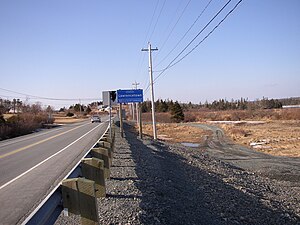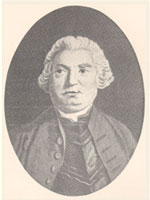Lawrencetown, Halifax County, Nova Scotia: Difference between revisions
→Notable residents: Reverting two recent addidtions. No information provided to back them up as actually being notable. Being a sales rep or a bee keeper are questionable as being notable enough to be in an encyclopedia to begin with. |
Hantsheroes (talk | contribs) |
||
| Line 8: | Line 8: | ||
[[File:CharlesLawrenceNovaScotiaHistoricalSocietyc.1753.jpg|thumb|right|300px|[[Charles Lawrence (British Army officer)|Charles Lawrence]]]] |
[[File:CharlesLawrenceNovaScotiaHistoricalSocietyc.1753.jpg|thumb|right|300px|[[Charles Lawrence (British Army officer)|Charles Lawrence]]]] |
||
In 1754, [[Nova Scotia]]'s [[lieutenant governor|Lieutenant Governor]] [[Charles Lawrence (British Army officer)|Charles Lawrence]], offered land grants to twenty families, who referred to their settlement as Lawrence's Town, which became Lawrencetown. The Acadians and natives resisted the British occupation of Nova Scotia and Acadia by raiding the various communities. By June 1757, the settlers had to be withdrawn completely from the settlement of [[Lawrencetown, Halifax County, Nova Scotia|Lawrencetown]] because the number of Indian raids eventually prevented settlers from leaving their houses.<ref>Bell Foreign Protestants. p. 508</ref> |
In 1754, [[Nova Scotia]]'s [[lieutenant governor|Lieutenant Governor]] [[Charles Lawrence (British Army officer)|Charles Lawrence]], offered land grants to twenty families, who referred to their settlement as Lawrence's Town, which became Lawrencetown. The Acadians and natives resisted the British occupation of Nova Scotia and Acadia by raiding the various communities. In late April 1754, Beausoleil and a large band of Mi'kmaq and Acadians left Chignecto for Lawrencetown. They arrived in mid-May and in the night open fired on the village. Beausoliel killed and scalped four british settlers and two soldiers. By August, as the raids continued, the residents and soldiers were withdrawn to Halifax.<ref>Diane Marshall. Heroes of the Acadian Resistance. Formac. 2011. p. 110-111</ref> By June 1757, the settlers had to be withdrawn completely again from the settlement of [[Lawrencetown, Halifax County, Nova Scotia|Lawrencetown]] because the number of Indian raids eventually prevented settlers from leaving their houses.<ref>Bell Foreign Protestants. p. 508</ref> |
||
It is located on the [[Eastern Shore (Nova Scotia)|Eastern Shore]], 8 kilometres due east of the entrance to [[Halifax Harbour]]. |
It is located on the [[Eastern Shore (Nova Scotia)|Eastern Shore]], 8 kilometres due east of the entrance to [[Halifax Harbour]]. |
||
Revision as of 20:08, 21 October 2011

Lawrencetown (2006 population: 668) is a Canadian rural community in Nova Scotia's Halifax Regional Municipality on Route 207.
History
Father Le Loutre's War began when Edward Cornwallis arrived to establish Halifax with 13 transports on June 21, 1749.[1] By unilaterally establishing Halifax the British were violating earlier treaties with the Mi'kmaq (1726), which were signed after Dummer's War.[2] The British quickly began to build other settlments. To guard against Mi'kmaq, Acadian and French attacks on the new protestant settlements, British fortifications were erected in Halifax (1749), Dartmouth (1750), Bedford (Fort Sackville) (1751), Lunenburg (1753) and Lawrencetown (1754).

In 1754, Nova Scotia's Lieutenant Governor Charles Lawrence, offered land grants to twenty families, who referred to their settlement as Lawrence's Town, which became Lawrencetown. The Acadians and natives resisted the British occupation of Nova Scotia and Acadia by raiding the various communities. In late April 1754, Beausoleil and a large band of Mi'kmaq and Acadians left Chignecto for Lawrencetown. They arrived in mid-May and in the night open fired on the village. Beausoliel killed and scalped four british settlers and two soldiers. By August, as the raids continued, the residents and soldiers were withdrawn to Halifax.[3] By June 1757, the settlers had to be withdrawn completely again from the settlement of Lawrencetown because the number of Indian raids eventually prevented settlers from leaving their houses.[4]
It is located on the Eastern Shore, 8 kilometres due east of the entrance to Halifax Harbour.
The community name of Lawrencetown was adopted on October 4, 1921, but changed to 'East Lawrencetown' on July 3, 1952. It was reinstated as Lawrencetown on April 5, 1961.
Notable residents
- Lesley Choyce, author, professor, and TV host.
- Bob Crowell, local produce supplier
- Jimmie Inch, engineer, singer/songwriter, radio host[5]
- Dan Logan, musician, songwriter, performer, traveller (Dan Logan @ Grafton St. Dinner Theatre)
- Scout Logan, runner up mixed breed competitor, International dog show, Louisville 1999
- Seth Logan, coastal engineer, singer/songwriter (Seth Logan @ Myspace Music)
References
Texts
- Grenier, John. The Far Reaches of Empire. War in Nova Scotia, 1710-1760. Norman: U of Oklahoma P, 2008.
- Griffiths, Naomi Elizabeth Saundaus. From Migrant to Acadian: A North American border people, 1604-1755. Montreal, Kingston: McGill-Queen's UP, 2005.
- Murdoch, Beamish. A History of Nova Scotia, Or Acadia. Vol 2. LaVergne: BiblioBazaar, 2009. pp. 166–167
- Wicken, William. Mi'kmaq Treaties on Trial: History, Land, and Donald Marshall Junior. University of Toronto Press. 2002.
Links
- ^ Grenier, John. The Far Reaches of Empire. War in Nova Scotia, 1710-1760. Norman: U of Oklahoma P, 2008; Thomas Beamish Akins. History of Halifax, Brookhouse Press. 1895. (2002 edition). p 7
- ^ Wicken, p. 181; Griffith, p. 390; Also see http://www.northeastarch.com/vieux_logis.html
- ^ Diane Marshall. Heroes of the Acadian Resistance. Formac. 2011. p. 110-111
- ^ Bell Foreign Protestants. p. 508
- ^ East Coast Countdown: About us. Retrieved April 28, 2010.

